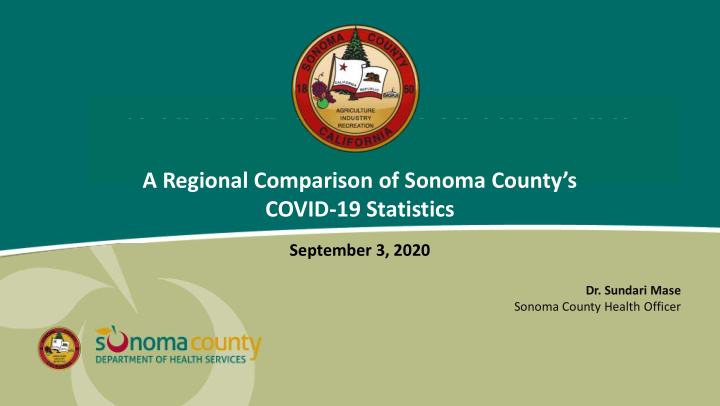



A Regional Comparison of Sonoma County’s COVID-19 Statistics September 3, 2020 Dr. Sundari Mase Sonoma County Health Officer
Blueprint for a Safer Economy • On August 28 th , Governor Newsom introduced the Blueprint for a Safer Economy, a new four tier structure for reducing COVID- 19 with revised criteria for loosening and tightening restrictions on activities. • This framework replaces the former County Data Monitoring criteria 2
Four Tiers 3
How does Sonoma County compare to the Region and State? • Sonoma County is one of 38 counties in the State in Tier 1 (purple): Widespread Transmission 4
Measure of Spread The R-effective refers to the average number of additional people infected by each COVID-19 case (<1 decreasing spread, >1 increasing spread) 5
COVID-19 Cases by City 6
Regional Comparison: Case Rate • New cases per 100,000 per day (7 day average; 7 day lag) Sonoma 15.6 Alameda 10.8 Contra Costa 10.8 San Francisco 9.8 Solano 9.1 Santa Clara 8.6 San Mateo 8.6 Napa 6.5 Marin 5.9 7
Regional Comparison: Testing Positivity • Seven day testing positivity (7 day average; 7 day lag) Sonoma 10.6% Alameda 6.2% Contra Costa 6.2% San Mateo 4.8% Solano 4.3% Napa 4.2% Santa Clara 3.5% San Francisco 3.4% Marin 3.0% 8
Differing Drivers of Infection • It is important to keep in mind that Sonoma County has a few key differences from our Bay Area neighbors: – Sonoma County is home to tourism, agriculture, industry. – Essential workers in Sonoma County live and work within our border. – Marin and Napa have a smaller population base and essential workers who cannot afford to live in these counties can commute from other places. – Contra Costa, Alameda, Marin and San Francisco do not share similar industries, including agriculture and food production.
Different Approaches to Testing In addition to these differences, Sonoma County has adopted aggressive case finding strategies: • Sonoma County Department of Health Services has an agile, responsive testing team that conducts active case finding at worksites, communities, facilities and vulnerable populations. • The network of community clinics and other major health care providers make testing available to all persons accessing care, including family members. • Sonoma County has a fully staffed public health laboratory able to prioritize testing based on shifts in the outbreak. • Two OptumServe sites are also available for rapid testing. 10
Comparison County Considerations • While geographically close, our neighboring counties have different drivers impacting their case rates. • To look at a more comparable example, the county of Monterey might be considered. Like Sonoma County, Monterey County has: – A similar population size and demographics – Substantial tourism – Strong agriculture and food production industries – Essential workers live and work within boundaries 11
Comparison of Case Statistics County New Cases per 100,000 per Day Testing Positivity Sonoma 15.6 10.6% Monterey 15.5 10.9% Monterey County Cases Sonoma County Cases 12
Race/Ethnicity of Cases 73% Latinx 50% 21% Other/Unknown 31% 4% White, non-Hispanic 16% 1% Asian/Pacific Islander 2% 5% Black/African American 1% 0% 10% 20% 30% 40% 50% 60% 70% 80% Monterey Sonoma Similar to Sonoma County, Monterey County has experienced a disproportionate number of cases in the Latinx community and outbreaks among Agriculture and Farm workers 13
Cases by Age Group 25% 23% 19% 19% 20% 17% 15% 15% 15% 14% 15% 13% 12% 11% 9% 9% 10% 6% 5% 0% 0-17 18-24 25-34 35-44 45-54 55-64 65+ Sonoma Monterey Similar trends seen in cases by age groups, with the 25-34 year old age group accounting for the largest proportion of cases in both counties 14
Conclusions • Sonoma County’s pattern of cases is similar to other counties that share our demographic, industry and tourism profiles • Focused case finding efforts, extensive field testing in vulnerable populations (e.g. skilled nursing facilities) and worksites, and systematic testing of close contacts have yielded a high number of positive cases 15
What Can Sonoma County do to Slow the Spread of COVID-19? • Continue focused approach to testing, contact tracing and data- driven case finding • Reinforce importance of wearing facial coverings, social distancing, hygiene, wearing masks when ride sharing, and avoiding gathering • Encourage workers to stay home when ill and urge employers to provide sick leave when possible • Outreach to the agriculture industry, skilled nursing and other congregate and vulnerable settings to strengthen prevention and mitigation measures 16
Recommend
More recommend